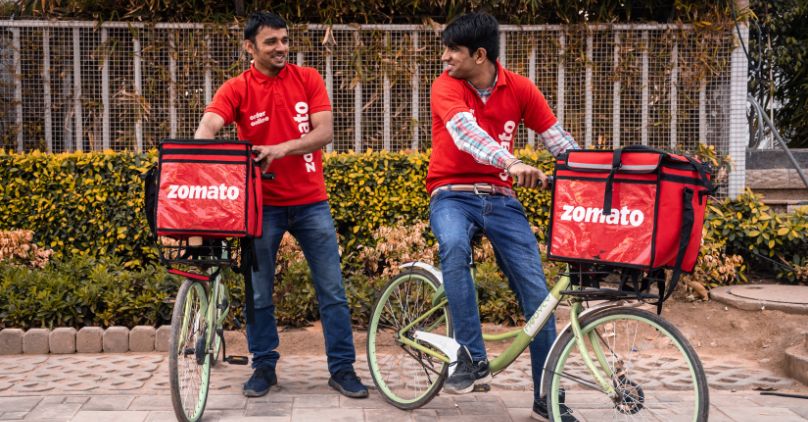In a move signalling heightened competition in India’s quick-commerce sector, Zomato announced plans to raise $1 billion through a share sale to institutional investors. This is the company’s first major fundraising effort since its 2021 IPO, and it comes just weeks before its primary competitor, another Indian quick-commerce decacorn Swiggy, is set to go public, aiming to raise $1.4 billion.
The timing has drawn significant attention as it positions Zomato to solidify its foothold in the evolving market for rapid grocery deliveries and other goods. Back in 2022,
What is the major update?
Zomato’s quick-commerce subsidiary, Blinkit, has been a central focus in the company’s expansion strategy. The quick-commerce sector, which promises deliveries in minutes, has revolutionised consumer behavior in India and disrupted traditional e-commerce models. With competition intensifying from companies like Swiggy, Zepto, and BigBasket, Zomato’s capital raise appears to be aimed at maintaining its competitive edge.
A key reason for this raise, as analysts suggest, maybe to reduce foreign institutional ownership in Zomato. The current regulatory environment in India prohibits foreign-owned companies from engaging in inventory-based business models. By decreasing foreign ownership, Zomato could transition Blinkit into a model where it controls inventory, thus offering greater flexibility and reducing operational costs. Reports online further noted that such a shift would enable Blinkit to “launch and scale new categories beyond grocery” more effectively.
Zomato’s financial position
Despite raising eyebrows with its decision to pursue additional capital, Zomato remains financially strong. In the quarter ending in September, the company reported a profit of $20.9 million on revenues of $570 million, reflecting a 70% year-on-year increase. This robust financial performance is accompanied by steady growth in food delivery margins, while the quick-commerce division remains close to breakeven.
CEO Deepinder Goyal addressed these financials in a letter to shareholders, stating, “While we believe that capital by itself does not give anyone the right to win, we want to ensure that we are on a level playing field with our competitors.” This statement reveals the reality that in the fast-evolving and capital-intensive quick-commerce sector, maintaining sufficient liquidity is crucial.
Industry implications and Blinkit’s role
Zomato’s acquisition of Blinkit has placed the company in the leading position in India’s quick-commerce market, a sector expected to generate $6.5 billion in annual revenue. As Goyal noted, competition in the space has only intensified. Swiggy, backed by major investors like Prosus Ventures, SoftBank, and Accel, remains a formidable competitor. Swiggy’s IPO is expected to raise $1.4 billion in the coming weeks, a move that will likely fortify its resources for growth and expansion.
Adding to the competitive dynamics, Zepto, a Mumbai-based quick-commerce startup, is also seeking additional capital, reportedly raising around $100 million from Indian investors. The influx of capital into this sector highlights its rapid growth and the desire of multiple players to carve out a substantial market share.
Blinkit’s potential adoption of an inventory-based model, made possible through Zomato’s shift toward domestic ownership, could give it a significant advantage. Owning and controlling inventory would allow Blinkit to manage its supply chain more effectively, reduce dependence on external vendors, and experiment with new product categories.
Why quick-commerce?
The quick-commerce trend, which involves delivering groceries, office supplies, and various other items to customers in minutes, has altered the expectations of Indian consumers. Traditional e-commerce models, with longer delivery times and higher logistical costs, have been challenged by these new models. According to other reports, India’s quick-commerce sector has exceeded initial expectations and is poised for sustained growth.
Analysts suggest that while the early days of quick-commerce were defined by large-scale investments and rapid expansion, the next phase of growth will depend on operational efficiency, innovation in delivery mechanisms, and the ability to offer a wider variety of products beyond basic groceries.
Strategic capital deployment
Zomato’s decision to raise $1 billion has puzzled some analysts, particularly given the company’s existing cash reserves of $1.2 billion. However, the influx of capital seems aimed at shoring up resources ahead of an increasingly competitive period. Goyal’s emphasis on creating a “level playing field” suggests that Zomato intends to be well-positioned to compete with Swiggy and other rivals.
Other online report also pointed out that quick-commerce companies typically generate thin margins from grocery delivery, often relying on 2% of Gross Order Value (GOV) from vendors to cover operational costs. Having the capital to absorb operational losses and invest in new categories may be critical for Zomato’s continued dominance in this sector.
What do we think about the update
Zomato’s decision to raise $1 billion ahead of Swiggy’s IPO reflects the intensifying competition in India’s quick-commerce market. With both companies vying for market leadership, capital reserves will be essential for securing long-term growth and profitability. While Zomato remains financially stable, the additional funding will likely support Blinkit’s transition into an inventory-based model, which could improve operational efficiency and open new revenue streams.
As the quick-commerce sector evolves, the challenge for companies like Zomato and Swiggy will be not only to maintain their market share but also to innovate, delivering superior service quality and expanding beyond traditional grocery deliveries.
The post India’s quick-commerce war intensifies: Everything to know about Zomato’s $1B share sale strategy ahead of Swiggy IPO appeared first on Tech Funding News.
